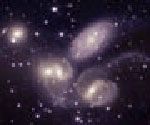Galactic Ballet Captured by Gemini

Stephan’s quintet as viewed by Gemini
A stunning image released by the Gemini Observatory captures the graceful interactions of a galactic ballet, on a stage some 300 million light years away. The clarity of the image is thanks, in part, to an instrument built in the UK, the Gemini Multi-Object Spectrograph (GMOS).
The galaxies, members of a famous troupe called Stephan’s Quintet, are literally tearing each other apart. Their shapes are warped by gravitational interactions occurring over millions of years. Sweeping arches of gas and dust trace the interactions and possible ghost-like passage of the galaxies through one another. The ongoing dance deformed their structures while spawning a prolific fireworks display of star formation fuelled by clouds of hydrogen gas – clumped together to form stellar nurseries.
This unprecedented image of the cluster provides a unique combination of sensitivity, resolution and field of view. “It doesn’t take long to reach an incredible depth when you have an 8-metre mirror collecting light under excellent conditions,” said Travis Rector of the University of Alaska, Anchorage who helped obtain the data with the Gemini North Telescope on Mauna Kea, Hawaii. “We were able to capture these galaxies at many different wavelengths or colours. This allowed us to bring out some remarkable details in the final colour image that have never been seen before in one view.”
The GMOS instrument, which was built as a joint partnership between the UK Astronomy Technology Centre (UK ATC), University of Durham and the Hertzberg Institute of Astrophysics in Canada, is capable of obtaining hundreds of spectra in a single “snapshot” – enabling the study of galaxies at vast distances, as well as delivering high resolution images of this nature.
Dr Adrian Russell, Director of the UK ATC, adds, “The success of instruments like GMOS shows why the UK is at the forefront of world astronomy. This particular image demonstrates the exquisite detail that can be achieved when you use a state-of-the-art instrumentation to exploit an 8-metre class telescope on a great site.”
One striking element of the image is a collection of vibrant red clumps that mark star-forming regions within one of the galaxies – NGC 7320. Although its relation to the other galaxies in the cluster has been the subject of some controversy, most astronomers now think that the galaxy leads a relatively tranquil existence in the foreground, safely isolated from the violent quarrels of the more distant cluster. See notes to editors for further information about the image.
Media Contact
All latest news from the category: Physics and Astronomy
This area deals with the fundamental laws and building blocks of nature and how they interact, the properties and the behavior of matter, and research into space and time and their structures.
innovations-report provides in-depth reports and articles on subjects such as astrophysics, laser technologies, nuclear, quantum, particle and solid-state physics, nanotechnologies, planetary research and findings (Mars, Venus) and developments related to the Hubble Telescope.
Newest articles

Pinpointing hydrogen isotopes in titanium hydride nanofilms
Although it is the smallest and lightest atom, hydrogen can have a big impact by infiltrating other materials and affecting their properties, such as superconductivity and metal-insulator-transitions. Now, researchers from…

A new way of entangling light and sound
For a wide variety of emerging quantum technologies, such as secure quantum communications and quantum computing, quantum entanglement is a prerequisite. Scientists at the Max-Planck-Institute for the Science of Light…

Telescope for NASA’s Roman Mission complete, delivered to Goddard
NASA’s Nancy Grace Roman Space Telescope is one giant step closer to unlocking the mysteries of the universe. The mission has now received its final major delivery: the Optical Telescope…



